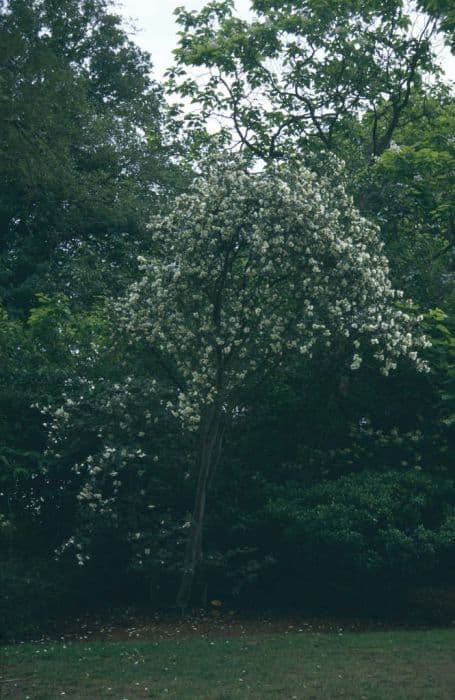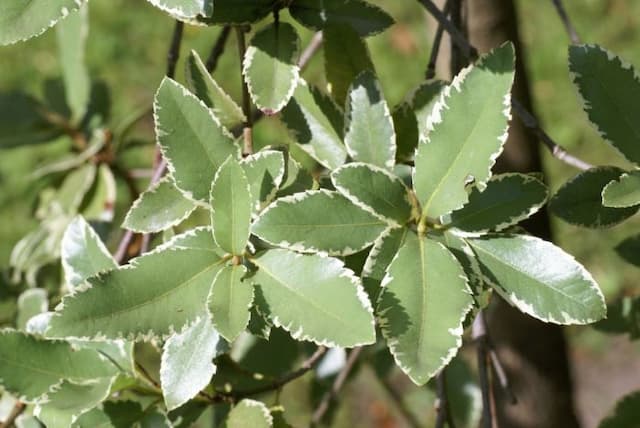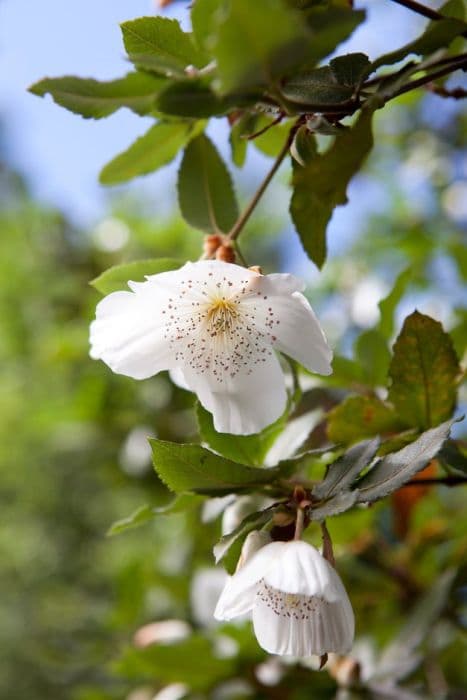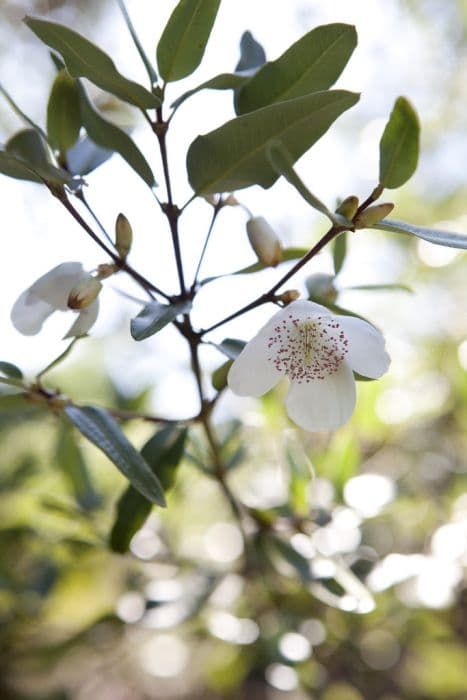Milligan's Eucryphia Eucryphia milliganii

ABOUT
Eucryphia milliganii, commonly known as Milligan's Leatherwood, is a small evergreen shrub that is renowned for its attractive appearance. Its foliage consists of small, glossy, dark green leaves, which provide a dense and finely textured backdrop throughout the year. The plant is adorned with delicate, white flowers that emerge in great profusion. These blooms are quite noticeable and are composed of four petals that form a cross-like shape with a bunch of prominent yellow stamens at the center, adding a splash of color. These stamens are attention-grabbing and give the flower a distinctive and decorative appearance. The contrast between the dark green leaves and the bright white flowers makes Milligan's Leatherwood particularly eye-catching when in bloom. The overall form of the shrub is neat and compact, making it a favored choice for gardeners looking to add an evergreen structure with seasonal interest.
About this plant
 Names
NamesFamily
Cunoniaceae
Synonyms
Milligan's Eucryphia, Tasmanian Leatherwood
Common names
Eucryphia milliganii.
 Toxicity
ToxicityTo humans
Leatherwood, also known as Eucryphia milliganii, is not commonly known to be toxic to humans. There is limited information on its toxicity, as it is primarily appreciated for its ornamental value and is not typically ingested. Therefore, there are no well-documented symptoms of poisoning from consuming Leatherwood.
To pets
Leatherwood, the common name for Eucryphia milliganii, is not widely recognized as a toxic plant to pets, including cats and dogs. Similar to its effects on humans, there is scant information regarding its potential toxicity to pets, and it is not usually known for being poisonous. Therefore, there are no well-reported symptoms of poisoning in pets from consuming any parts of the Leatherwood plant. However, it is always advisable to prevent pets from ingesting plants not intended for consumption, as individual reactions may vary.
 Characteristics
CharacteristicsLife cycle
Perennials
Foliage type
Evergreen
Color of leaves
Green
Flower color
White
Height
6-10 feet (1.8-3 meters)
Spread
4-6 feet (1.2-1.8 meters)
Plant type
Shrub
Hardiness zones
9
Native area
Tasmania
Benefits
 General Benefits
General Benefits- Ornamental Value: Leatherwood (Eucryphia milliganii) offers aesthetic appeal with its attractive foliage and white flowers, making it popular for garden landscapes.
- Habitat Support: It provides habitat and food for various fauna including pollen for bees and habitat for birds.
- Biodiversity Enhancement: Leatherwood contributes to biodiversity when incorporated into gardens and natural landscapes.
- Shade Provider: The plant can offer shade due to its growth habit, making it suitable for planting in sunny areas.
- Windbreak: When planted in groups, Leatherwood can act as a windbreak, offering protection for gardens and other plants.
- Cultural Significance: Leatherwood has local cultural value in certain regions, particularly in Tasmania where it is indigenous.
- Educational Interest: The plant's unique properties and the role it plays in its ecosystem can provide educational material for horticulturists and botanists.
- Erosion Control: Its root system can help stabilize soil and prevent erosion in certain settings.
 Medical Properties
Medical PropertiesThis plant is not used for medical purposes.
 Air-purifying Qualities
Air-purifying QualitiesThis plant is not specifically known for air purifying qualities.
 Other Uses
Other Uses- Eucryphia milliganii, commonly known as the Milligan's Leatherwood, can be used as a natural dye source for fabrics, yielding subtle earthy tones.
- The wood of Milligan's Leatherwood is fine-grained and can be used for crafting small, ornamental objects such as jewelry boxes or picture frames.
- The dark, dense foliage of the plant makes it an excellent option for creating secluded garden nooks or privacy screens in landscaping designs.
- Milligan's Leatherwood can act as a windbreak in gardens due to its robust and dense growth habit, helping to protect more delicate plants.
- The blossoms of Milligan's Leatherwood can be used in floral arrangements, adding a unique aesthetic due to their rarity and delicate appearance.
- Fallen leaves and bark from the plant can be used as mulch, providing soil enrichment and weed suppression for garden beds.
- For educational purposes, this uncommon species can be cultivated in botanical gardens as an example of Tasmania's diverse flora.
- Milligan's Leatherwood seeds can be utilized as a learning tool in seed-saving workshops, teaching the importance of biodiversity and conservation.
- The plant may be used as a reference for artists or illustrators specializing in botanical art, providing a rare subject for their work.
- Beekeepers in the vicinity of natural stands of Milligan's Leatherwood can find that the plant contributes to the production of a distinct type of honey, though it is not a primary source.
Interesting Facts
 Feng Shui
Feng ShuiThe Eucryphia is not used in Feng Shui practice.
 Zodiac Sign Compitability
Zodiac Sign CompitabilityThe Eucryphia is not used in astrology practice.
 Plant Symbolism
Plant Symbolism- Resilience: Eucryphia milliganii, commonly known as Milligan's Leatherwood, is native to Tasmania's rugged environments, symbolizing the ability to thrive under challenging conditions.
- Rarity: Due to its limited distribution and specific habitat requirements, Milligan's Leatherwood represents uniqueness and the precious nature of rare entities.
- Endurance: With its robust nature and evergreen leaves, Milligan's Leatherwood stands for endurance and the capacity to withstand temporal changes.
- Purity: The white flowers of the plant could be seen as a symbol of purity and innocence.
- Adaptability: Its ability to adapt to poor soil conditions signifies adaptability and finding a way to grow and prosper no matter the circumstances.
 Water
WaterThe Leatherwood should be watered once a week, making sure to keep the soil consistently moist but not waterlogged. Depending on the size of the plant and the environmental conditions, typically about 1 to 1.5 gallons of water should suffice each week during its growing season. Cut back on watering during the winter months when the plant is dormant, ensuring that the soil does not dry out completely.
 Light
LightThe Leatherwood thrives in partial shade or dappled sunlight. It is best to place the plant where it can be shielded from the intense midday sun, preferably in a spot that receives morning light and afternoon shade. This lighting condition will promote healthy growth without scorching its leaves.
 Temperature
TemperatureLeatherwood plants are hardy and can tolerate a range between 50°F to 70°F, with their ideal temperature being around 60°F to 65°F for optimal growth. They can survive down to 32°F but should be protected from severe frosts and temperatures that persistently go below freezing.
 Pruning
PruningPruning of the Leatherwood is beneficial to maintain its shape and encourage bushier growth. It should be done after the plant has finished flowering, typically in late summer or early fall. Remove any dead or damaged branches and shape the plant as necessary, cutting back up to one-third of the growth if needed.
 Cleaning
CleaningAs needed
 Soil
SoilTasmanian Leatherwood prefers moist, well-drained, acid to neutral soil with a pH between 5.5 and 7.0. A mixture of peat moss, coarse sand, and loamy soil in equal parts can create an ideal growing medium.
 Repotting
RepottingTasmanian Leatherwood should be repotted every 2-3 years or when it outgrows its current pot, ensuring minimal disturbance to the root system.
 Humidity & Misting
Humidity & MistingTasmanian Leatherwood thrives in moderate to high humidity levels, ideally between 50% and 70%, mimicking its native rainforest habitat.
 Suitable locations
Suitable locationsIndoor
Grow Tasmanian Leatherwood near a window with filtered light.
Outdoor
Plant Tasmanian Leatherwood in partial shade and sheltered spots.
Hardiness zone
9-11 USDA
 Life cycle
Life cycleEucryphia milliganii, commonly known as Milligan's Leatherwood, begins its life as a seed, which after dispersal typically germinates in moist, well-drained soil in its native habitat of Tasmania's cool temperate rainforests. Upon germination, the seedling goes through a phase of establishment where it develops its root system and initial foliage. As the plant enters the juvenile stage, it grows steadily, producing a shrub-like structure with dense, dark green foliage. It reaches maturity after several years and starts to bloom, producing small, white, fragrant flowers that attract pollinators such as bees. After successful pollination, it sets fruit that contains seeds, completing the reproductive cycle. These seeds are then dispersed through various means, including gravity and potentially by animals, allowing the cycle of growth and reproduction to continue.
 Propogation
PropogationPropogation time
Spring
Eucryphia milliganii, commonly known as Milligan's Eucryphia, is typically propagated by seed or cuttings. The most popular method for propagating Milligan's Eucryphia is through semi-hardwood cuttings, which is often done in late summer. To propagate, take semi-hardwood cuttings of about 4 to 6 inches (10 to 15 centimeters) in length from a healthy parent plant. The cut end of the cutting should be treated with rooting hormone to encourage root development before being placed in a well-draining potting mix. The cutting needs to be kept in a humid environment with consistent but indirect light. Once roots have formed, which can be checked by gently tugging on the cutting to feel for resistance, the new plant can be gradually acclimatized to less humid conditions and eventually transplanted outdoors.




